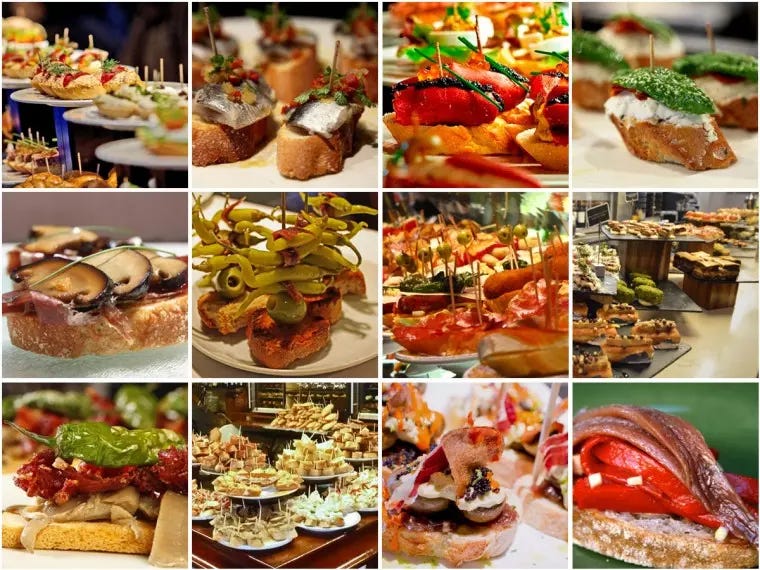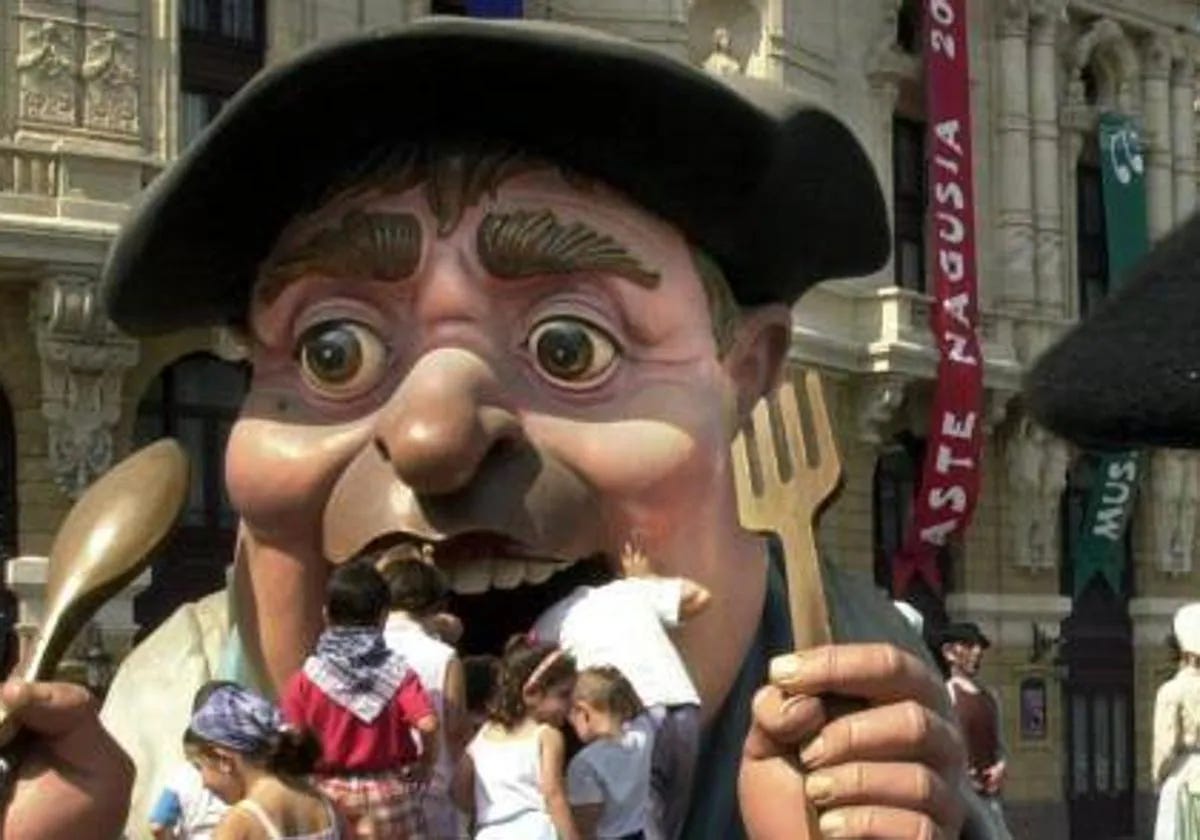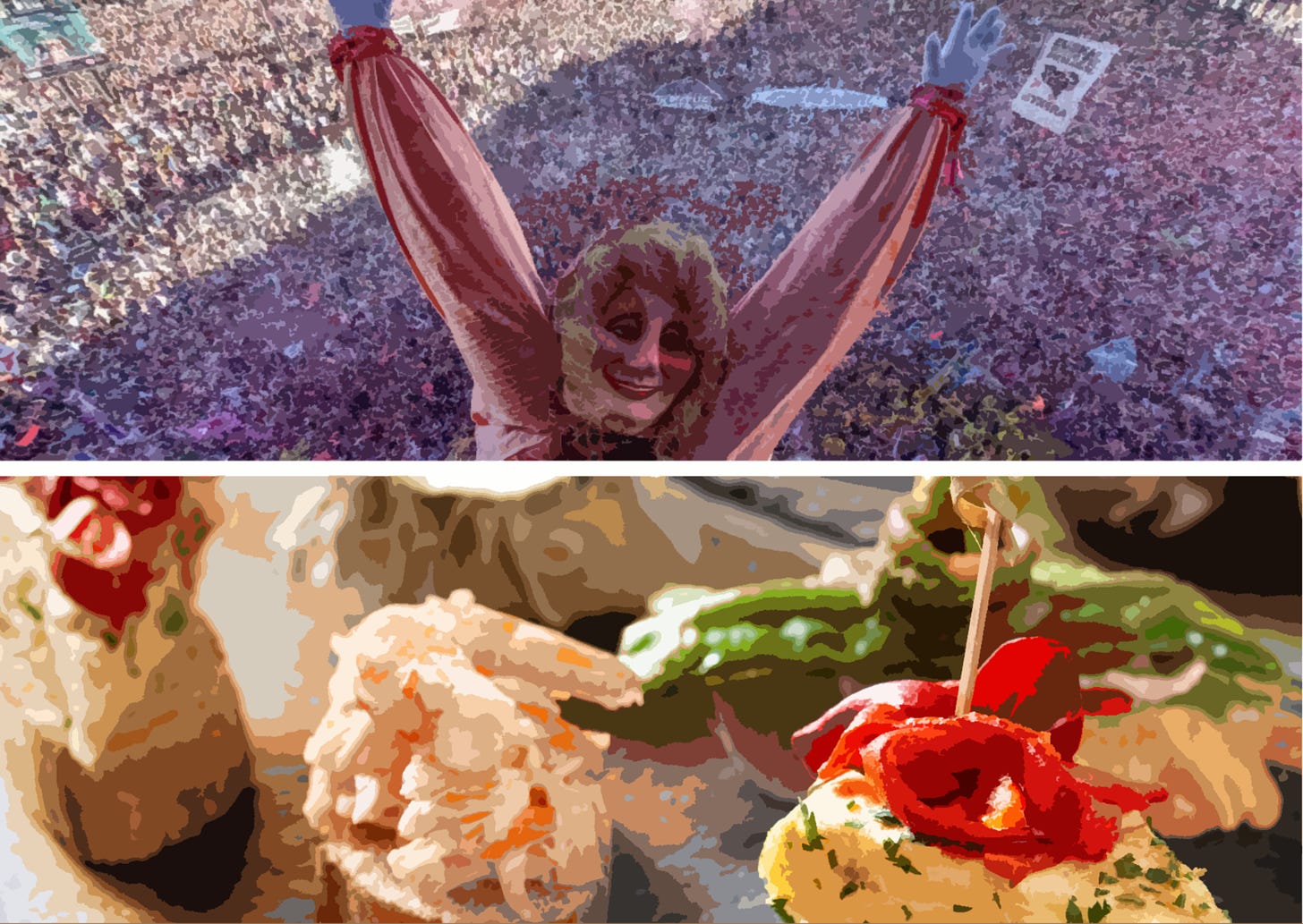🍾🎆 Bilbao's BIG WEEK and Pintxos!
Outdoor festivities mixed with world-famous Basque cuisine, the Aste Nagusia festival is a nine-day-long party for the senses!
Aste Nagusia
If you see a tall, large-buttocked woman in a head scarf, arms extended to the sky, gyrating her generous hips in a joyful dance above an enthusiastic crowd who are singing along to the music in a flurry of confetti, streamers, and flags, then you’ve probably found yourself in the middle of the Basque Country’s largest and most popular festival.
This iconic character of the Aste Nagusia festival was designed in 1978 to represent the newly formed festivities to be held every August in Bilbao. The ‘Marigaia’, with her cheery, red-cheeked papier mâché face framed in a headscarf and her colourful (and more importantly – flammable) skirt and shirt is held together with grass and a triangular frame. Inside the skirt, someone can be harnessed to make her move and dance, which is what she does from the balcony of Arriagen Theatre to kick off the nine-day long festival known as Big Week.

The largest city in the Basque Country, located some16 km (10 miles) south of the Bay of Biscay in the north of Spain, is surrounded by lush mountain ranges and is famous for its Guggenheim Museum, historic and picturesque old town, and a thriving pintxos culture.
Kalean da dena
“Everything is in the streets” is a Basque phrase which sums up the spirit of a festival full of processions, street performances, folkloric dances, outdoor concerts, a circus and fairground, open air markets and workshops, sporting games, and pyrotechnic contests. There are gastronomic workshops and competitions for young and old, and of course, the essential txikitea – the Basque tradition of bar hopping, or a tapas crawl.
An experienced txikitero doesn’t hit the bars with just a friend, but with their ‘cuadrilla’ – a large group experienced in the art of pub crawling - having a few bite-sized pintxos and a txikiti (small glass of wine), or zurito (small beer) before moving on to the next place. Because tapas are truly an artform in Bilbao, and they take their food very seriously.

Perfect Pintxos
I say “bite-sized” but it would take a generous mouth to fit the majority of these multi-stacked creations.
Pintxos (or pinchos in Spanish) generally consist of a slice of bread topped with layers of ingredients pierced together with a long toothpick, or spike, from which they get their name. They range from the simple topping of potato omelette, or jamon, to the more elaborate and sophisticated edible sculptures that make use of the region’s renowned seafood, cheeses, meats, and salsas. They can be served hot or cold but are usually found displayed upon the bar’s countertop ready to be chosen and eaten quickly. Easier said than done when faced with such delicious variety.
The best place to do a pintxo crawl, or txikitea, is in Bilbao’s Casco Viejo (Old Town) with its narrow streets and abundance of bars and restaurants. Bars such as Bar El Globo, which is one of the oldest in Bilbao and has an incredible variety of pintxos. Or Bar La Viña del Ensanche, famous for its codfish omelette pintxo made with deep-fried desalted cod, onion and garlic, and Bar Irrintzi which offers a truffled quail egg pintxo. Ledesma Street, another popular route for a txikitea, has the Bar Zuga with its famous foie gras and fig jam pintxo, and Bar Charli with its variety of seafood pintxos.

New Basque Cuisine
The Basque Country has produced some of the most world-famous chefs, responsible for shaping its international reputation as a leading force in the culinary arts. Chefs such as Juan Mari Arzak and his daughter Elena Arzak, Martin Berasategui, Andoni Luis Aduriz, Pedro Subijana, and Karlos Arguinano helped establish the region as a global culinary hotspot.
In the 1970s and 80s, many Basque chefs were influenced by the “nouvelle cuisine” developed in France and borrowed its simple ingredients and elegant presentation to create their own unique dishes with Basque ingredients and flavours. The nearby coastline offers up the tuna, shellfish, squid and octopus, spider crabs, goose barnacles, baby eels, and more, that make their way into the pintxo menu. Then there are the unique cheeses such as Idiazabal, cured hams, ciders, and Txakoli - a slightly sparkling, dry white wine with high acidity that is a popular choice with pintxos.

The end of a Big Week
The festival finishes at 10pm with the dramatic farewell to Marijaia, who is placed on a floating platform on the river and set alight in a blaze of glory. It’s a slightly gruesome sight, but encapsulates both a farewell to the festival and an anticipation of its return the following year.
So whether you go for the joy and excitement of Bilbao’s Big Week of activities and performances, or to indulge in the gastronomic delights of its bars and restaurants, (or both), August is the best time to visit the Basque city.





going to spain soon and I am very excited to eat pintxos!